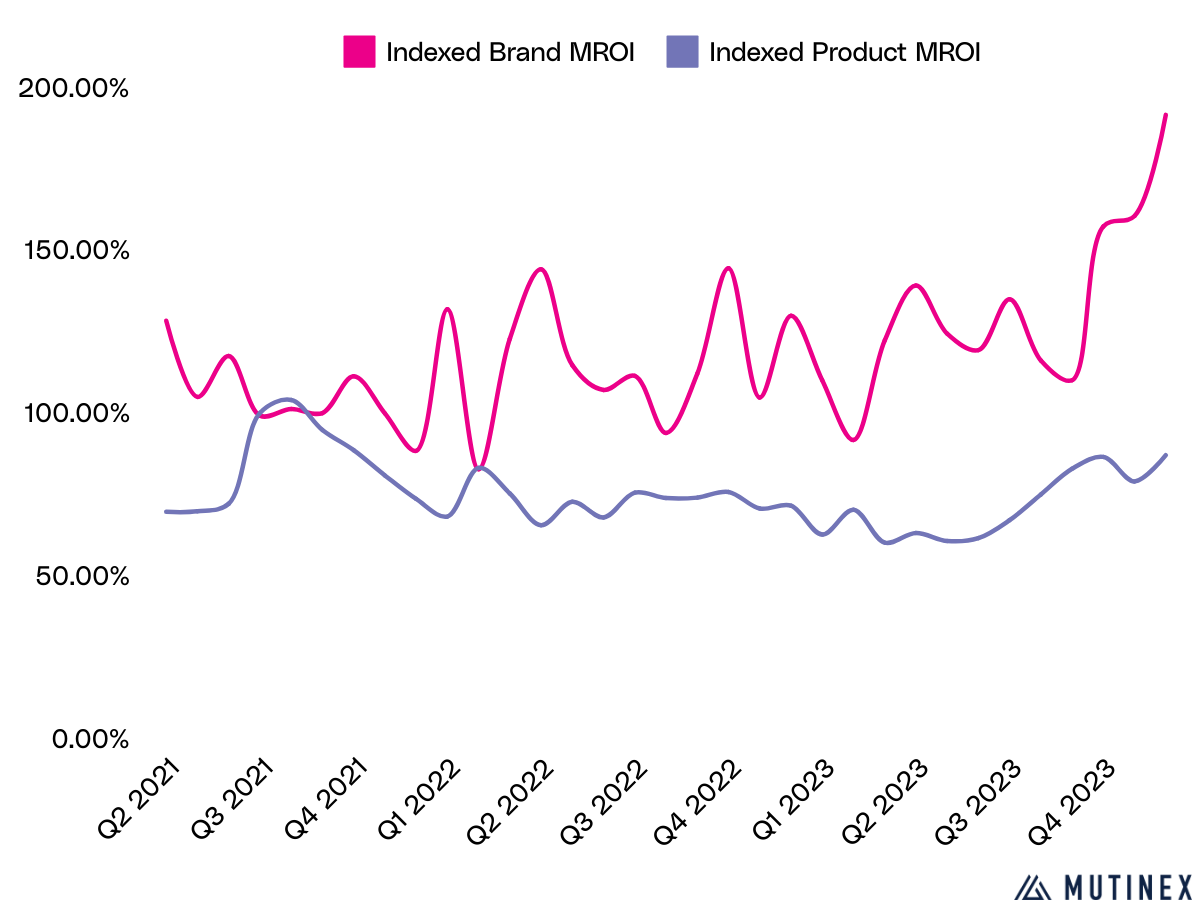For the modern marketer, especially those at the helm of large or enterprise level companies, Marketing Mix Modeling has become an integral component of your marketing strategy.
With overwhelming amounts of data and an ever-growing number of channels, parsing out ROI and effectiveness can become a fraught affair.
Furthermore, communicating marketing effectiveness to the c-suite while pointing out the effectiveness of your marketing spend can often be a source of contention. This is where Marketing Mix Modeling comes into play.
To shed some light on what Marketing Mix Modeling is,its significance in contemporary marketing strategies, and how businesses can leverage it to enhance their ROI and decision-making processes, we created this comprehensive guide.
Ok, let’s get into it…
A brief definition of Marketing Mix Modeling
Marketing Mix Modeling, often abbreviated as ‘MMM’, is a statistical analysis technique used by businesses to quantify the impact of various marketing inputs on sales.
Furthermore, MMM can then forecast the potential impact of future marketing strategies.
It provides insights into how the various elements of your marketing mix affect overall sales and profitability.
The Open MMM Validation Framework

What’s the importance of MMM in modern marketing?
In today’s hyper-competitive market, companies are constantly striving to optimize their marketing strategies.
MMM plays a key role here as it provides a data-driven approach to ascertaining which of your marketing activities are driving results and which are falling short.
By identifying the most effective strategies, you can then allocate your marketing budget more effectively, achieve better return on investment (ROI), and gain a tool in your belt to frame your marketing spend in terms of subsequent revenue.
You can summarise the real guts of why MMM is important in three main points.
ROI maximization
By identifying which marketing activities contribute most to sales, you and your company can then allocate resources in a smarter and more effective way.
Improved decision-making
You’ll rarely find a company that doesn’t value making better decisions. When you deploy MMM you enable data-driven insights, which in turn help you make informed decisions on your marketing strategies and budget allocation.
Better internal communication
A key issue for many marketers is the ability to hold internal conversations around marketing spend, budgets, effectiveness, and ROI with those in sales and the c-suite. MMM provides a data led common language which can help you frame these conversations.
What are the applications of Marketing Mix Modeling?
In real terms, how would you apply MMM in your company and what would you use it for?
- Budget allocation; Optimizing marketing spend across different channels based on their proven effectiveness.
- Campaign planning: Forecasting outcomes and conducting scenario analysis to refine marketing strategies.
- Performance measurement: Tracking key performance indicators (KPIs) to evaluate the success of marketing efforts.
Understanding the Marketing Mix
So what’s meant by ‘Marketing Mix’ anyway? What does it entail?
You can break down the Marketing Mix by segmenting it into what’s known as ‘the four Ps’ The four Ps are Product, Price, Promotion, and Place.
Let’s get into more detail when it comes to the four Ps shall we?
Product
The product element refers to your focus on the features and benefits of the specific product or service you’re promoting.
Price
Pretty self-explanatory here, the price element is around developing the best pricing strategy that aligns with your consumer’s expectations, as well as the prevailing market conditions.
Promotion
Strategies to communicate the value proposition of the product through advertising, sales promotion, etc.
Place
Place is all about making sure that you’ve conveniently made sure your product or service is available to your target consumers at the right place and time.
How has the concept of Marketing Mix evolved over time?
Over time, as with many concepts, the way we think about Marketing Mix has changed from a pretty simple framework to a sophisticated analytical concept that incorporates advanced statistical methods and data analytics. We now see this expressed in tools like MMM.
Previously, we’d see MMM delivered in a consultancy model. Nowadays? You can do this in-house and live with saas.
How does Marketing Mix Modeling actually work?
Enough theory, how does MMM actually work in practice?
Data Collection and analysis
MMM relies on various types of data, including sales data, marketing expenditures, external factors (such as economic conditions).
Data Sources
The sources of this data could be internal sales records, market research data, competitor data, etc.
Modeling techniques
When it comes to how you construct the model, you can use statistical methods like ‘regression analysis’ which will help you model the relationships between marketing inputs and outcomes.
In modern times, however, we use ‘Bayesian modeling’ for advanced MMM delivered as saas.
What are the key components of Marketing Mix Models?
Your key MMM components are essentially a range of variables and drivers that are considered, measured, and weighed. Like what?
Your main drivers
- Incremental drivers: Factors directly influenced by marketing efforts, such as advertising and promotional activities.
- Base drivers: Factors that impact sales independently of current marketing activities, such as brand reputation.
- Other drivers: External factors like seasonality and macroeconomic conditions that affect consumer behavior.
Your main variables
- Incremental variables: incremental variables speak to the impact of your advertising channels such as TV, digital, print, and promotional activities, on your sales.
- Base variables: Your base variables include factors like brand equity and broader economic trends that influence your sales.
- Other variables: There are also a range of other important variables to consider like seasonal fluctuations, and certain economic factors in the your modeling process.
How would you go about implementing Marketing Mix Modeling?
Before you implement an MMM solution and start pulling out useful information, you’ll need to do some preparatory work.
Steps to developing a Marketing Mix Model
- Data preparation: You’ll need to be well prepared. This prep involves gathering and cleaning relevant data sources.
- Model building: When you get to building a model that suits your company, you’ll be applying statistical techniques to develop the MMM.
- Validation and calibration: How do you know it’s functioning properly and accurately? You’ll need to test the model against historical data to ensure accuracy.
Common challenges with implementing MMM
- Handling missing data: Techniques like imputation or excluding incomplete data points.
- Dealing with Outliers: Identifying and addressing data points that skew results.
Case studies and examples of MMM in action
Successful Implementation of MMM can seriously improve a company’s marketing efforts and measurement. Here’s a few Mutinex customers who’ve found success with our GrowthOS MMM software.
- Samsung Case Study: How did Samsung improve their marketing investment performance with near real-time data?
- Asahi Case Study: How did Asahi Beverages refinine their media investment strategies with marketing mix modeling?
- Youi Case Study: How did Youi demonstrate brand revenue contribution and ROI to the board on a single page?
Future trends in Marketing Mix Modeling
How do we predict MMM might evolve and change over time? Here’s a few trend predictions we think could be on the cards.
- The increased impact of digital transformation: As the digital landscape changes, MMM will adapt to account for the rise of digital marketing channels and shifting consumer behavior.
- Integration with advanced analytics and AI: This is already underway We’re going to see the utilization of AI and machine learning to enhance the predictive capabilities of MMM models and make them more user friendly.
- Emerging variables and new channels: We’ll certainly see the need to incorporate new variables like social media metrics and influencer marketing into MMM frameworks.
Final thoughts on the importance of MMM
As marketing continues to evolve, MMM stands out as a critical tool for businesses looking to stay competitive and maximize their marketing investments. It also comes down to ‘future proofing’ your marketing measurement.
At the end of the day, Marketing Mix Modeling can empower you and your company to better navigate the increasing complexities of the modern marketing landscape by providing actionable insights that are derived from comprehensive data analysis.
By leveraging MMM effectively, your company can achieve greater efficiency and effectiveness in your marketing efforts, ultimately driving sustainable business growth and sales revenue.




